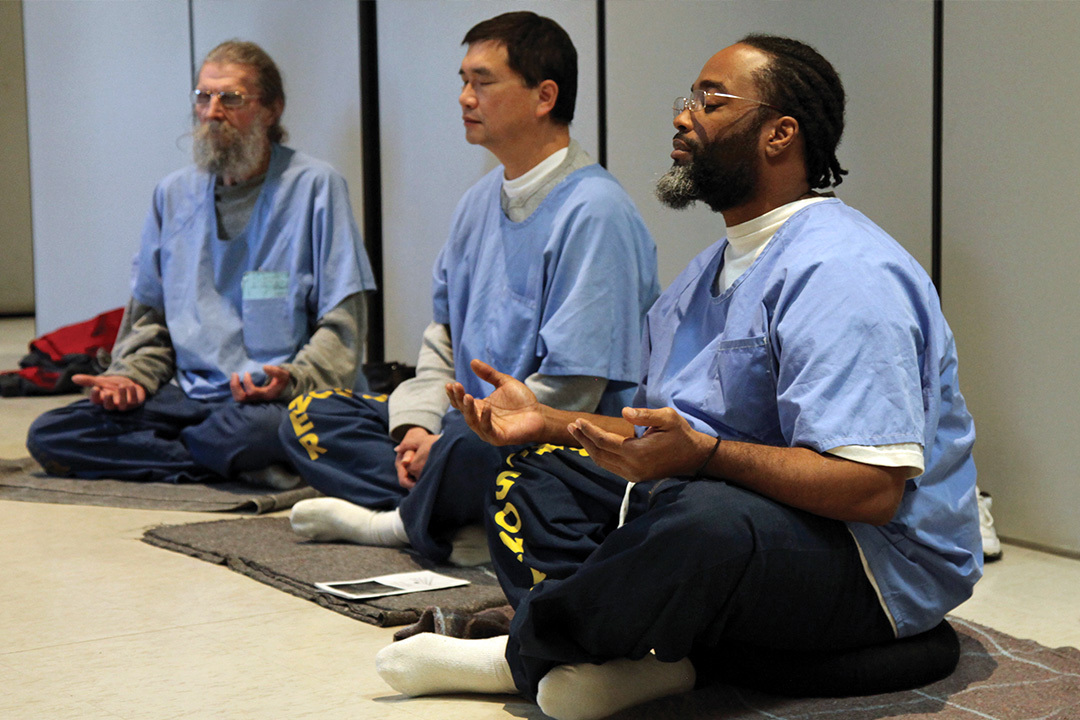Diane Wilde and Buddhist Pathways Prison Project
Diane and “Rondell,” one of the first people to “graduate” from the program and to be released from prison. buddhistpathways.org
Fifteen years ago, if you had told Diane Wilde that she’d soon be meditating with maximum-security inmates, including many gang members with violent convictions, she wouldn’t have believed you. Then her eldest son, a bona fide addict, was incarcerated. Ashamed and racked with guilt, she hid this truth until a woman at her local sangha asked if she’d volunteer to teach Buddhist practices at Folsom Prison, in California—and Diane had an epiphany: She had been running away from her suffering, rather than toward it. She immediately said yes and thereby found her calling.
When she started, in 2003, four volunteers were going to Folsom Prison. As the program found its feet, more prisons requested Buddhist services, and in 2010 Diane formalized the program as the nonprofit Buddhist Pathways Prison Project (BP3). They started volunteer trainings to help fill the growing requests and now do a yearly training retreat. Currently, there are over 75 volunteers teaching in 22 California prisons.
Many of the inmates have life sentences and are looking for ways to better cope with the realities of living in jail. The volunteers remind them that, regardless of their faith tradition, they can change how they think through meditation and daily mindfulness practice. Some are serious about creating a life practice, while others want a quick fix and don’t last.
When a group meets, they start with mindful movement, usually 20–25 minutes of yoga to kick-start the body/mind connection. Then they sit in silence for 5–10 minutes with guidance, checking in with questions like “Be honest. How is that sitting for you? Be honest about what’s going on. Is it hard?” Diane says the vast majority regard the opportunity to be quiet as a relief, since prison—with its clanging doors, piercing alarms, and rowdy population—is rarely peaceful. She also notes that over 70 percent of inmates suffer from PTSD, and some find silence terrifying.
Transformations at Buddhist Pathways
Buddhist Pathways serves over 20 prisons, bringing Buddhist teachings and mindfulness to incarcerated sangha members through group meditation and silent retreats. Yet Diane Wilde says,“I have 10 inmates who are teachers to me. They are able to change how they feel about their victims, themselves, and the world around them.” When asked what it takes to volunteer, Diane says she’s leery of those who say they want to “give them a chance.” She shares a quote from aboriginal elder Lilla Watson: “If you have come here to help me, you are wasting your time. But if you have come because your liberation is bound up with mine, then let us work together.”
For those who are ready, the program holds periodic daylong silent retreats. Along with yoga and sitting meditation in silence, they bring in an outside teacher for a dharma talk. They also provide a healthy vegetarian lunch and teach “eating meditation,” all in silence. Says Diane, “The men love these days.” As one inmate said, “This time provided the most peace I have felt in 25 years of incarceration.”
Diane cherishes meeting inmates one on one and letting them lead. Some inmates have become deep practitioners and want to talk about their practice. Others are just grateful to be honest with someone. It’s an opportunity to be vulnerable, scared, and sad. Grappling with guilt is a huge issue—guilt for their family, for themselves. She says, “There’s relief in their talking. And that’s fulfilling. They stay in touch, even when they transfer. They can start addressing their life now, letting go of their facade, their hate, their gang.”
“Rondell” was one of the first people to “graduate” from the program and be released from prison. He is now working as a truck driver, saving money to purchase his first home, and volunteering as a board advisor to incarcerated individuals for BP3.

Solano State Prison in Vacaville, California
When asked about the challenges of offering these services, Diane recalled a time where the prison system required her to integrate Southern California gang members with Northern gang members, who historically had deep hatred for one another. The Southerners were experienced practitioners, while the Northerners had not been to Buddhist services. The day would consist of seven hours of silence—no easy task—so she met with each group separately to ensure that they were comfortable prior to making the commitment. That day, there were 40 men, 10 volunteers, and armed guards on the catwalk.
At the end, one of their volunteers told everyone to get in a circle and hold hands. Diane said the anticipation of this moment was nerve-racking and the guards were prepared for the worst. Surprisingly, everyone held hands. When they were asked, “Be honest—what was the day like?” some confessed that it was difficult, but the most frequent comment was “The hardest part of the day was leaving. Because this is the first time I felt like a human being.” Some of the Northerners joined in the sangha after the retreat. Wilde beams, adding “A day of silence! We didn’t solve anything, but it made a huge difference.”
—Alma Tassi
What you can do
If you have 10 minutes:
Sit in silence for 10 minutes, then ask yourself “Be honest. How is that sitting for you?”
If you have $35:
Contribute to the supplies for a daylong retreat such as a vegetarian meal.
If you have an hour:
Fill out a volunteer application and see where it takes you. buddhistpathways.org
If you feel inspired by someone:
Nominate the person or organization for a Be the Change Award. Email [email protected] with the subject line: Be the Change Nomination.


